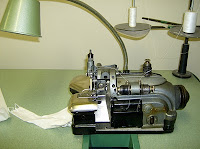
Industrial sewing machines are the workhorses of the wardrobe and of my studio space. They are heavy, will sew through virtually anything, and I can't imagine trying to work on anything else. I find that the best machines to purchase are the older ones with fewer bells and whistles. They have fewer things to go wrong. The first industrial machine I bought was this Consew straight stitch for $100.00. Best investment I ever made. It only goes forward-no reverse- so if you need to tack the beginning or end of the seam, you have to lift the foot pedal, pull the fabric back a few millimeters and stitch over your first few stitches.
I bough the industrial Pfaff zig zag machine when Steve from
Pro-Sewing found one and told me about it. I cost much more than the Consew did, but in the costuming area, a zig is very useful machine to have and I feel that this is one of the better ones.

I also have a very old Singer overlock machine-I'm not sure of its age but it still works very well. I use it mostly for finishing the seam allowance of garments.
I have a domestic serger that I use for rolled hem edges and for stretch fabrics too. It has a useful foot that allows elastic to feed through it without having to manually guide the elastic along.
I have a more modern Mitsubishi straight stitch machine that has a reverse lever and Carol has a Mauzer overlock at the studio as well.
I managed to get all these machines moved with the help of my husband and a manual fork lift. (He hopes I am happy with where they are situated so I won't have to ask for help to move them again.)

The other heavy duty piece of equipment I have is my old (bought it used 16 years ago) Sheldon industrial boiler and iron. When the seal went on the glass tube (which shows you the interior water level), surprisingly I got my local plumber to fix it- It will produce 30psi of steam and you can run it all day without refilling it. The iron is a heavier weight model for tailoring. The unit needs its own electrical breaker and it sits on a dedicated ironing table, covered in wool felt and wide enough to iron 150cm wide fabric. When this iron stops heating its life will be over since it has asbestos batting inside the bottom plate and no-one is allowed to work on them anymore.
So all the heavy items are now in the space, cleaned up and ready for whatever project next comes our way.
In the meantime I am back at my regular job contract. I have three shows assigned right now, so a bit of 30's and 40's style tailoring and a few doublets thrown in for good measure. I will work with new designers as well, so it should be an interesting season.
The process begins again.




This comment has been removed by a blog administrator.
ReplyDelete